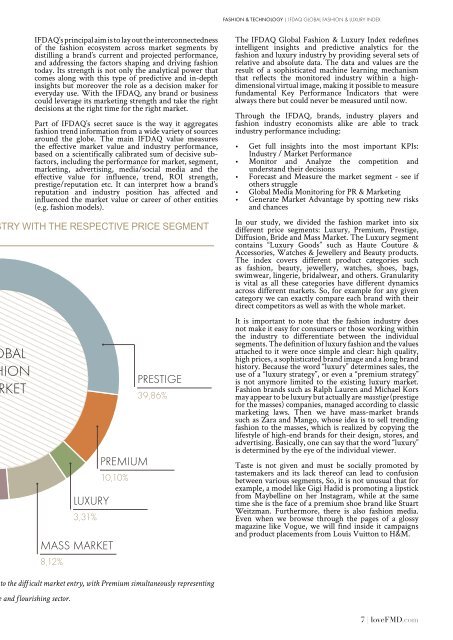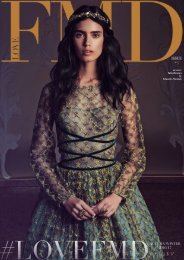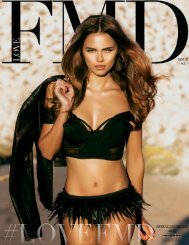loveFMD Magazine Issue8
The Spring/Summer 18 issue of loveFMD celebrates the spirit of renewal in all its splendor. Our 8th so far, the issue features Hungarian beauty Noemi Jonas on the cover. Inside, there’s plenty to inspire and distract: from gorgeous fashion spreads to trippy trend stories. What are you waiting for? Get your ‘ad free’ copy NOW!
The Spring/Summer 18 issue of loveFMD celebrates the spirit of renewal in all its splendor. Our 8th so far, the issue features Hungarian beauty Noemi Jonas on the cover. Inside, there’s plenty to inspire and distract: from gorgeous fashion spreads to trippy trend stories. What are you waiting for? Get your ‘ad free’ copy NOW!
Create successful ePaper yourself
Turn your PDF publications into a flip-book with our unique Google optimized e-Paper software.
FASHION & TECHNOLOGY | IFDAQ GLOBAL FASHION & LUXURY INDEX<br />
IFDAQ’s principal aim is to lay out the interconnectedness<br />
of the fashion ecosystem across market segments by<br />
distilling a brand’s current and projected performance,<br />
and addressing the factors shaping and driving fashion<br />
today. Its strength is not only the analytical power that<br />
comes along with this type of predictive and in-depth<br />
insights but moreover the role as a decision maker for<br />
everyday use. With the IFDAQ, any brand or business<br />
could leverage its marketing strength and take the right<br />
decisions at the right time for the right market.<br />
Part of IFDAQ’s secret sauce is the way it aggregates<br />
fashion trend information from a wide variety of sources<br />
around the globe. The main IFDAQ value measures<br />
the effective market value and industry performance,<br />
based on a scientifically calibrated sum of decisive subfactors,<br />
including the performance for market, segment,<br />
marketing, advertising, media/social media and the<br />
effective value for influence, trend, ROI strength,<br />
prestige/reputation etc. It can interpret how a brand’s<br />
reputation and industry position has affected and<br />
influenced the market value or career of other entities<br />
(e.g. fashion models).<br />
TRY WITH THE RESPECTIVE PRICE SEGMENT<br />
BAL<br />
ION<br />
KET<br />
8,12%<br />
LUXURY<br />
3,31%<br />
MASS MARKET<br />
PREMIUM<br />
10,10%<br />
PRESTIGE<br />
39,86%<br />
The IFDAQ Global Fashion & Luxury Index redefines<br />
intelligent insights and predictive analytics for the<br />
fashion and luxury industry by providing several sets of<br />
relative and absolute data. The data and values are the<br />
result of a sophisticated machine learning mechanism<br />
that reflects the monitored industry within a highdimensional<br />
virtual image, making it possible to measure<br />
fundamental Key Performance Indicators that were<br />
always there but could never be measured until now.<br />
Through the IFDAQ, brands, industry players and<br />
fashion industry economists alike are able to track<br />
industry performance including:<br />
• Get full insights into the most important KPIs:<br />
Industry / Market Performance<br />
• Monitor and Analyze the competition and<br />
understand their decisions<br />
• Forecast and Measure the market segment - see if<br />
others struggle<br />
• Global Media Monitoring for PR & Marketing<br />
• Generate Market Advantage by spotting new risks<br />
and chances<br />
In our study, we divided the fashion market into six<br />
different price segments: Luxury, Premium, Prestige,<br />
Diffusion, Bride and Mass Market. The Luxury segment<br />
contains “Luxury Goods” such as Haute Couture &<br />
Accessories, Watches & Jewellery and Beauty products.<br />
The index covers different product categories such<br />
as fashion, beauty, jewellery, watches, shoes, bags,<br />
swimwear, lingerie, bridalwear, and others. Granularity<br />
is vital as all these categories have different dynamics<br />
across different markets. So, for example for any given<br />
category we can exactly compare each brand with their<br />
direct competitors as well as with the whole market.<br />
It is important to note that the fashion industry does<br />
not make it easy for consumers or those working within<br />
the industry to differentiate between the individual<br />
segments. The definition of luxury fashion and the values<br />
attached to it were once simple and clear: high quality,<br />
high prices, a sophisticated brand image and a long brand<br />
history. Because the word “luxury” determines sales, the<br />
use of a “luxury strategy”, or even a “premium strategy”<br />
is not anymore limited to the existing luxury market.<br />
Fashion brands such as Ralph Lauren and Michael Kors<br />
may appear to be luxury but actually are masstige (prestige<br />
for the masses) companies, managed according to classic<br />
marketing laws. Then we have mass-market brands<br />
such as Zara and Mango, whose idea is to sell trending<br />
fashion to the masses, which is realized by copying the<br />
lifestyle of high-end brands for their design, stores, and<br />
advertising. Basically, one can say that the word “luxury”<br />
is determined by the eye of the individual viewer.<br />
Taste is not given and must be socially promoted by<br />
tastemakers and its lack thereof can lead to confusion<br />
between various segments, So, it is not unusual that for<br />
example, a model like Gigi Hadid is promoting a lipstick<br />
from Maybelline on her Instagram, while at the same<br />
time she is the face of a premium shoe brand like Stuart<br />
Weitzman. Furthermore, there is also fashion media.<br />
Even when we browse through the pages of a glossy<br />
magazine like Vogue, we will find inside it campaigns<br />
and product placements from Louis Vuitton to H&M.<br />
to the difficult market entry, with Premium simultaneously representing<br />
and flourishing sector.<br />
7 | <strong>loveFMD</strong>.com










